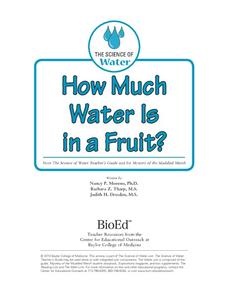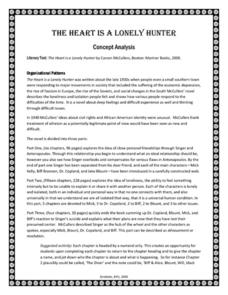Baylor College
How Much Water Is in a Fruit?
Compare the volume of an orange to the volume of liquid that can be extracted out of it. Also compare the mass of an apple before and after it has been dried out. In both of these activities, children find that there is an appreciable...
Wind Wise Education
Where is it Windy?
How is the wind up there? The class builds a topography model using materials available in the classroom, then place wind flags in different locations on the landscape. Using a fan as a wind source, pupils collect data about how wind...
WindWise Education
What is Wind Power's Risk to Birds?
How is risk determined? Through the use of a reading passage, individuals or groups learn about bird interactions with man made structures along with wind turbines. Pupils use information from the second reading passage to conduct an...
Curated OER
There Is/There Are And School Life
For this school supplies and "there is/there are" online worksheet, students enter the names of six school supplies that are shown by clip art pictures, they unscramble the names of school subjects, and use drop-down menus to choose...
Texas State Energy Conservation Office
Are Your Computers Wasting Energy?
After reading about the amount of energy that is used to power a personal computer, learners take a look at their own computer use and therefore, their energy consumption. They do this through a series of questions and computations on...
Howard Hughes Medical Institute
Human Feet Are Strange
Feet are neat! So, if you've already walked the path of examining animal footprints with your class, put them in the shoes of early humans! A well-designed lesson incorporates video, discussion, and hands-on learning to demonstrate how...
Baylor College
What Is a Neuron?
Your class won't get on your nerves while doing this modeling activity! After teaching the structure and function of a neuron using the included diagrams, give individuals some clay and chenille stems so that they can make their own...
American Physiological Society
Hoo Eats Who and What is What in Your Own Backyard?
Bird is the word! Teach life science scholars the importance of our feathered friends and the roles they play in our ecosystem. Using the plan, learners investigate the birds in their areas, determine the biotic and abiotic factors that...
Novelinks
The Heart Is a Lonely Hunter: Concept Analysis
Considering Carson McCullers' The Heart Is a Lonely Hunter for whole-class reading or as a selection for book circles? Check out this resource that overviews the organizational patterns, themes, plot structure, tone, and setting.
Curated OER
What is Theme?
What is theme, and how can you find themes in literary works? These and other questions are answered by a colorful and engaging presentation that not only defines the term but also provides easy to understand examples. The slides...
Baylor College
What Is the Water Cycle?
Small groups place sand and ice in a covered box, place the box in the sunlight, then observe as evaporation, condensation, and precipitation occur. These models serve as miniature water cycles and demonstrations of the three phases of...
Baylor College
How Can We Find Out What Is in Water?
Using paper chromatography, water watchers discover that several substances might be dissolved even though they aren't visible. In this case, you will prepare a mixture of three different food colorings for them to experiment with. A...
California Academy of Science
How Big is Big?
In a math or life science class, "mini-me" models are created with cardstock to reflect a 1:10 scale of students' bodies. Learners measure each others' heights with meter sticks, and then reduce the size by 10. After this exercise, they...
Foundation for Water & Energy Education
How is Flowing Water an Energy Source? Activity A
Here is a fun little exploration of the potential energy potential of falling water. Learners drop water from various heights using a straw, and they analyze the diameter of the splash. Pair this with two more activities of the same...
Arbor Day Foundation
Trees are Terrific...Inside and Out!
Trees are the star of a three-step unit celebrating Arbor Day. Step one takes an in-depth look into the structure of a tree, the process of photosynthesis, and the benefits of the leafy giants. Step two challenges scholars to create a...
Curriculum Corner
The Answer Is Math Task Cards
Scholars work backwards to solve word problems with a practice page that gives an answer and asks, What is the problem?
Curated OER
Worksheet 1 There is/There are
English language learners will benefit from this focus on there is and there are. As they focus on the two forms, they create sentences using each, and they identify which group of words correctly completes the sentences provided. Five...
C3 Teachers
2020 Protests: Is There Anything New about the 2020 Protests?
Are marches and protests an effective form of resistance? That is the question high schoolers seek to answer in this inquiry lesson as they compare the 2020 protests to historical ones. Researchers use Venn Diagrams to compare images...
Curated OER
How Tall is the Gingerbread Man?
The gingerbread man has finally been caught, now find out how tall he is with this measurement activity. Using Unifix® cubes, marshmallows, buttons, and Cheerios, young mathematicians measure and record the height of the gingerbread man...
Curated OER
Using Is and Are
First graders discuss when to use "is" and "are" in a sentence. They practice using is and are correctly in sentences and practice writing sentences using "is" and "are" in their writing. Students complete a worksheet using is and are.
Curated OER
The Use of Is and Are - Subject/Verb Agreement
In this grammar worksheet set, students answer 68 questions on 5 pages in which they identify the proper use of the verbs is and are. They ensure that there is subject/verb agreement in each sentence by either choosing is or are, or...
Curated OER
Making Sentences: Using "is" and "are"
In this making sentences worksheet, students make sentences with the 2 words given to them and the word "is" or "are". Students complete 20 sentences.
Curated OER
The Heart is a Lonely Hunter: Venn Diagram
“When a person knows and can’t make the others understand, what does he do?” Why (s)he collects evidence and writes an essay! Prepare your readers for a compare/contrast or reflective essay on The Heart is a Lonely Hunter by giving them...
University of Colorado
Is There Life on Earth?
To find life on another planet, scientists look for gases (atmosphere), water, and temperatures that are not extreme. In this activity, groups of pupils become "Titan-ians," scientists who want to explore Earth for possible life forms....
Other popular searches
- Using Is and Are
- Be Verbs: Is Are
- Be Verbs Is Are
- There Is and There Are
- Verb Tense Is Are
- There Is" and "There Are
- There Is There Are
- Is and Are Verbs
- Is Are Was Were
- Am Is Are
- There Is/there Are
- Using Am/is/are

























